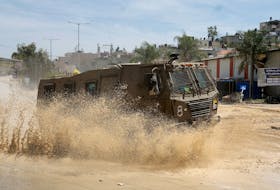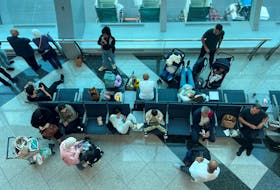The flight crashed in Gander nearly 50 years ago shortly after taking off from Gander International Airport, leaving 35 dead amid a burning pile of twisted metal.
Along with the Czech Ambassador to Canada, Zimova will return to Gander on June 27 to unveil a memorial that’s being erected by the Gander Airport Historical Society (GAHS).
According to Jack Pinsent, president of GAHS, the memorial will pay tribute to “those that perished in the crash, to those that survived and to honour those that assisted in the survival of 34 very fortunate people.”
The ceremony will take place at the Gander crash site at 2 p.m. on June 27.
Previous story published Sept. 16, 2014
It’s been nearly 50 years since Alena Zimova has been to Gander, but on the weekend she made an emotional return to the town to recognize a significant event that almost ended her life here.
Zimova is one of 34 people who survived when Czechoslovakian Airlines Flight 523 crashed on Sept. 5, 1967, shortly after taking off from Gander International Airport (GIA). The horrific crash left 35 dead amid a burning pile of twisted metal.
Now living in Barrie, Ontario, Zimova made the trip back to Gander on Sept. 13 with her son, Andre, and son-in-law, Alistair Ingram, who originally encouraged her to take a trip back to the crash site.
Jack Pinsent, an air traffic controller the morning of the crash, organized her visit to Gander with the help of current airport staff. Her visit included a tour of the crash site and a small informal get-together in the International Departures Lounge of GIA.
“I was surprised to be alive, and I feel very lucky to stand here today,” said Zimova, who came to live in Canada shortly after recovering from the crash. “I think about my colleagues who did not survive when I look out over there.”
It is an emotional but vivid memory for Zimova, who was airlifted to a Halifax burn unit shortly after receiving preliminary care at the James Paton Memorial Regional Health Centre.
“The doctor was accompanying me because I couldn’t walk . . . my leg was badly hurt and it took a long time for my skin to grow back,” said Zimova. “I had heavy burns on my legs — it was just flesh. I had several surgeries that I didn’t know about because I was unconscious most of the time.”
The burns weren’t the only injuries she suffered in the crash.
“My left knee was totally separated when I woke up,” said Zimova. “I put myself in a sitting position. I could hardly see but when I looked down I saw the end of my thigh bone.”
That injury made the process of treating the burns to her legs all the more difficult.
“They put it back together but I couldn’t move because I was in such bad shape. My knee separated again when we got to Halifax so they fixed it with surgery. My leg was in a cast but the bandages for my burns had to changed every day. The doctors came in and
sawed out a section of my cast that they could remove to treat the burns. Then they tied it back together and every morning they would have to untie it and treat the leg.”
Now in her 80s, Zimova was just 33 years old when the plane took off for Havana, Cuba, around 2:40 a.m. According to reports from the time, the weather that morning was good, adding even more to the mystery of the crash.
Frank Tibbo was an arrival controller the morning of the crash, and he recounted details of the tragedy in his aviation column in The Beacon.
“While the aircraft’s radio operator was changing frequency, the aircraft’s right wing struck the guy wire of a radar reflector mast that was located 4,000 feet from the end of the runway. (It broke the guy wire and dragged it 670 ft. beyond the mast),” wrote Tibbo.
“One hundred feet later, numbers two, three and four propellers started to nick the ground shrubs, and 20 ft. later the belly of the aircraft made contact with the ground. Shortly after, it hit the railway track embankment and rails, skipped 400 ft. over a depression in the ground, and crashed into boggy ground, breaking the wings into several sections and the fuselage into seven major parts. The aircraft caught fire immediately, and continued to burn for approximately six hours.”
According to Tibbo, the official report on the crash stated the “probable cause was undetermined.”
According to Zimova, investigators from the Czech government have never acknowledged her testimony that the plane was on fire before crashing, and that’s something she wants known.
Seeing the flames before the plane crashed saved her life, said Zimova, who was sitting towards the rear of the plane.
“I unbuckled in the airplane when the fire started, and I went into survival mode. I wanted to run away so I stood up but I said ‘I cannot go anywhere.’ I had both hands over my face. It’s not an opinion that fire started before the crash; it is a fact with capital letters. There was an explosion and fire when we were up in the air then we went down. I remember every moment of it, and I remember everything I saw that morning.”
Local connection
While many of the people involved with the rescue effort have since passed on, there are a few people left, and they also remember a lot about the crash.
Maurice Geange was one of the firefighters who responded to the 1967 crash. It was a scene he will never forget.
“It was pitch black that morning,” said Geange. “It was probably one of the darkest nights that had been around for a long time.”
The darkness began to fade, said Geange, as the team of firefighters neared the crash site and flames lit up the black, early-morning sky.
“There were survivors walking out to meet us as we got closer. They saw the lights from the rescue vehicles,” he said. “We brought down lighting power plants, flashlights, stretchers, first-aid equipment and stuff like that. That’s most of what we carried down until the helicopter got on the go. All that was left of the plane was the tailpiece.”
Austin Garrett, who has since passed on, was the helicopter pilot who performed the challenging aerial rescue that morning.
Garrett has been hailed as a hero over the years, as he performed the daring rescue mission through challenging conditions such as low visibility as a result of the dark sky and thick smoke. A street in Gander has been since named after him.
While accessing the boggy area alongside the former train tracks was difficult, rescue workers were faced with another major challenge —communication.
“We were trying to get all of the survivors in a bunch, but we couldn’t communicate because our language was different,” said Geange, noting the survivors were of several different nationalities. “We were trying to round them all up in one place, so when the rescue took place we’d be able to get them better. They were cold, wet and in shock and where we couldn’t communicate with them it made it a bit difficult. But when a person is in pain and agony, you know what they want — they want blankets and whatever help you can give them.”
The area of the crash site made rescue operations difficult, but it could have also prevented even more deaths, said Geange.
“You can really thank God that she went in the bog because had she landed on a harder surface, you might not have had any survivors.”
The scene was equally as chaotic for medical staff, said Ethel Fogwell, who was working as a nurse on the morning of the crash.
“I remember a lot of it,” said Fogwell. “There were about 35 people in the big ward that was there. I just remember the terror they had because they didn’t know where they were and who we were for that matter.”
Fogwell also recalls the difficulty of communicating with survivors.
“You couldn’t talk to them,” she said. “I remember putting IVs on patients, and they were looking to see what was in them but they couldn’t read what they were getting so they didn’t know. There was one man who was talking and he died while I was in the middle of seeing to him. A lot of them didn’t know if their family or significant other was saved, so eventually we found out who made it and who never.”
Both Fogwell and Geange had not been in contact with any of the survivors since the crash. While neither of them remembered Zimova from that day, they are thankful for the opportunity to be a part of her return to Gander.
Pinsent is happy to have been a part of her return trip to Gander.
“That she returned to Gander after all these years is fantastic for the town, for the airport, and it was great for her too,” said Pinsent. “It’s something that she has been living with for a long time, and she got a lot off of her chest just telling people what happened.”
Zimova expressed her gratitude to all those involved with the crash and her return trip to Gander.
“I’m very grateful for this, and thankful to the people who helped me then and now.”
The flight crashed in Gander nearly 50 years ago shortly after taking off from Gander International Airport, leaving 35 dead amid a burning pile of twisted metal.
Along with the Czech Ambassador to Canada, Zimova will return to Gander on June 27 to unveil a memorial that’s being erected by the Gander Airport Historical Society (GAHS).
According to Jack Pinsent, president of GAHS, the memorial will pay tribute to “those that perished in the crash, to those that survived and to honour those that assisted in the survival of 34 very fortunate people.”
The ceremony will take place at the Gander crash site at 2 p.m. on June 27.
Previous story published Sept. 16, 2014
It’s been nearly 50 years since Alena Zimova has been to Gander, but on the weekend she made an emotional return to the town to recognize a significant event that almost ended her life here.
Zimova is one of 34 people who survived when Czechoslovakian Airlines Flight 523 crashed on Sept. 5, 1967, shortly after taking off from Gander International Airport (GIA). The horrific crash left 35 dead amid a burning pile of twisted metal.
Now living in Barrie, Ontario, Zimova made the trip back to Gander on Sept. 13 with her son, Andre, and son-in-law, Alistair Ingram, who originally encouraged her to take a trip back to the crash site.
Jack Pinsent, an air traffic controller the morning of the crash, organized her visit to Gander with the help of current airport staff. Her visit included a tour of the crash site and a small informal get-together in the International Departures Lounge of GIA.
“I was surprised to be alive, and I feel very lucky to stand here today,” said Zimova, who came to live in Canada shortly after recovering from the crash. “I think about my colleagues who did not survive when I look out over there.”
It is an emotional but vivid memory for Zimova, who was airlifted to a Halifax burn unit shortly after receiving preliminary care at the James Paton Memorial Regional Health Centre.
“The doctor was accompanying me because I couldn’t walk . . . my leg was badly hurt and it took a long time for my skin to grow back,” said Zimova. “I had heavy burns on my legs — it was just flesh. I had several surgeries that I didn’t know about because I was unconscious most of the time.”
The burns weren’t the only injuries she suffered in the crash.
“My left knee was totally separated when I woke up,” said Zimova. “I put myself in a sitting position. I could hardly see but when I looked down I saw the end of my thigh bone.”
That injury made the process of treating the burns to her legs all the more difficult.
“They put it back together but I couldn’t move because I was in such bad shape. My knee separated again when we got to Halifax so they fixed it with surgery. My leg was in a cast but the bandages for my burns had to changed every day. The doctors came in and
sawed out a section of my cast that they could remove to treat the burns. Then they tied it back together and every morning they would have to untie it and treat the leg.”
Now in her 80s, Zimova was just 33 years old when the plane took off for Havana, Cuba, around 2:40 a.m. According to reports from the time, the weather that morning was good, adding even more to the mystery of the crash.
Frank Tibbo was an arrival controller the morning of the crash, and he recounted details of the tragedy in his aviation column in The Beacon.
“While the aircraft’s radio operator was changing frequency, the aircraft’s right wing struck the guy wire of a radar reflector mast that was located 4,000 feet from the end of the runway. (It broke the guy wire and dragged it 670 ft. beyond the mast),” wrote Tibbo.
“One hundred feet later, numbers two, three and four propellers started to nick the ground shrubs, and 20 ft. later the belly of the aircraft made contact with the ground. Shortly after, it hit the railway track embankment and rails, skipped 400 ft. over a depression in the ground, and crashed into boggy ground, breaking the wings into several sections and the fuselage into seven major parts. The aircraft caught fire immediately, and continued to burn for approximately six hours.”
According to Tibbo, the official report on the crash stated the “probable cause was undetermined.”
According to Zimova, investigators from the Czech government have never acknowledged her testimony that the plane was on fire before crashing, and that’s something she wants known.
Seeing the flames before the plane crashed saved her life, said Zimova, who was sitting towards the rear of the plane.
“I unbuckled in the airplane when the fire started, and I went into survival mode. I wanted to run away so I stood up but I said ‘I cannot go anywhere.’ I had both hands over my face. It’s not an opinion that fire started before the crash; it is a fact with capital letters. There was an explosion and fire when we were up in the air then we went down. I remember every moment of it, and I remember everything I saw that morning.”
Local connection
While many of the people involved with the rescue effort have since passed on, there are a few people left, and they also remember a lot about the crash.
Maurice Geange was one of the firefighters who responded to the 1967 crash. It was a scene he will never forget.
“It was pitch black that morning,” said Geange. “It was probably one of the darkest nights that had been around for a long time.”
The darkness began to fade, said Geange, as the team of firefighters neared the crash site and flames lit up the black, early-morning sky.
“There were survivors walking out to meet us as we got closer. They saw the lights from the rescue vehicles,” he said. “We brought down lighting power plants, flashlights, stretchers, first-aid equipment and stuff like that. That’s most of what we carried down until the helicopter got on the go. All that was left of the plane was the tailpiece.”
Austin Garrett, who has since passed on, was the helicopter pilot who performed the challenging aerial rescue that morning.
Garrett has been hailed as a hero over the years, as he performed the daring rescue mission through challenging conditions such as low visibility as a result of the dark sky and thick smoke. A street in Gander has been since named after him.
While accessing the boggy area alongside the former train tracks was difficult, rescue workers were faced with another major challenge —communication.
“We were trying to get all of the survivors in a bunch, but we couldn’t communicate because our language was different,” said Geange, noting the survivors were of several different nationalities. “We were trying to round them all up in one place, so when the rescue took place we’d be able to get them better. They were cold, wet and in shock and where we couldn’t communicate with them it made it a bit difficult. But when a person is in pain and agony, you know what they want — they want blankets and whatever help you can give them.”
The area of the crash site made rescue operations difficult, but it could have also prevented even more deaths, said Geange.
“You can really thank God that she went in the bog because had she landed on a harder surface, you might not have had any survivors.”
The scene was equally as chaotic for medical staff, said Ethel Fogwell, who was working as a nurse on the morning of the crash.
“I remember a lot of it,” said Fogwell. “There were about 35 people in the big ward that was there. I just remember the terror they had because they didn’t know where they were and who we were for that matter.”
Fogwell also recalls the difficulty of communicating with survivors.
“You couldn’t talk to them,” she said. “I remember putting IVs on patients, and they were looking to see what was in them but they couldn’t read what they were getting so they didn’t know. There was one man who was talking and he died while I was in the middle of seeing to him. A lot of them didn’t know if their family or significant other was saved, so eventually we found out who made it and who never.”
Both Fogwell and Geange had not been in contact with any of the survivors since the crash. While neither of them remembered Zimova from that day, they are thankful for the opportunity to be a part of her return to Gander.
Pinsent is happy to have been a part of her return trip to Gander.
“That she returned to Gander after all these years is fantastic for the town, for the airport, and it was great for her too,” said Pinsent. “It’s something that she has been living with for a long time, and she got a lot off of her chest just telling people what happened.”
Zimova expressed her gratitude to all those involved with the crash and her return trip to Gander.
“I’m very grateful for this, and thankful to the people who helped me then and now.”








